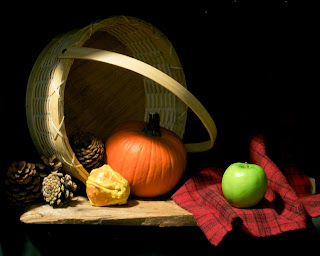- cool highlights in the upper left of the pumpkin's face which appear to me as a pale yellow-white.
- warm reflections in the contained shadows on the bottom part and right side. The base has picked up some of the warm ochres in the wood. The right side is warmed by the deep reds from the adjacent red cloth. And on the top, I can see modest browns reflected from the basket above. For all of these areas, I mixed cadmium orange with red madder (for warmth) or mars orange (for a muted brown-orange).
- a band of cool orange-greys just above bottom shadow. These are half-tones that have been cooled with grey. The challenge for me is that they also reveal the texture of the pumpkin, especially its pits, gouges, lines, and pimples in a variety of a oranges, some warm, some cool.
- variations of a warm and intense cadmium orange on the face of the pumpkin. The area below and above the highlight seems to show the strongest orange.
This colour pattern of cool, warm, cool and warm is not unlike what you'd see in a human face or figure. My model isn't moving but it is beginning to rot...
Below is a closeup of this week's work, followed by another photo of the full setup.
These photos unfortunately don't capture the range of colours and values, especially in the shadows...
Nature deserves better.



























